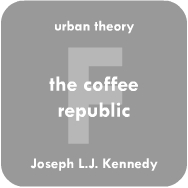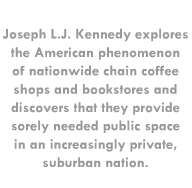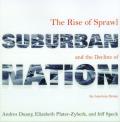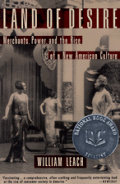

America has become a suburban nation. If the evidence of one's own eyes is not enough, one has only to look at the weight alone of the tome published last year by the eminent urban planners Anders Duany and Elizabeth Plater-Zyberk to see just how perplexing and compelling the issue of suburbanization can be.
The last time I drove around an American suburb, I must admit, was around nine months ago. It was the day after Christmas, and my mother and I briefly escaped the glitz and hypermodernist intimidation of Las Vegas. We drove the twenty minutes or so to Henderson, Nevada, and found there everything one would need to live one's life, but no space in which to do it, except for the thousands of tract homes that sprawled as far as the foothills of the Sierras.
I say 'no space', but in several of the strip centres we drove past were perfect replicas of the coffee houses that I've oft sprawled out in, in Austin, London and Denver. Replicas, for sure. Mere simulacra. There's something disarmingly clean about a suburban java house (those wishing to see how filthily charming the central city equivalent can be are urged to make their way to Austin, and check out Spiderhouse), and something profoundly discomforting about the exactness of its menu.
To me, coffee houses are indicative of nothing if not the cobbled together, freeform, downtown culture so beloved of those with PowerBooks but no obvious income. You get charged what the barista wants to charge you; at least once a week someone tries to pick you up; you read; you think; you hide from the errant boyfriend; you try to write the Great American Novel.
Suburbia isn't about this public living of one's life. It's about privacy, real privacy. With the eight-inch set included with every Levitt house, the privatisation of everyday life was compounded as the evening's entertainment began to be centred on the black and white screen in the corner of the living room. Television is the true medium of suburbia. As such, its representation of America's central cities deserves close scrutiny.
Many of the most memorable mimetic heroes from television's early days were suburbanites themselves, but as the years have worn on, the hip urbanite has often taken centre stage. From Mary Richards to Ellen Morgan, the city dweller has provided an exotic otherness for the resident of the exurbs; their romantic and professional adventures are inspiration to stay-at-homes and wannabes alike, none more so than the trite but phenomenally successful adventures of a group of New York twentysomethings, as detailed every Thursday night since the fall of 1994 in NBC's Friends.
As the title suggests, much of the nation's ongoing attraction to the series comes from its ability to make viewers in subdivisions and commuter towns feel as if they're part of some ubercool urban elite. Friends is a suburbanite's view of the central cities, which we see in living colour as the characters' interpersonal relationships develop in Central Perk.
I would hesitate to say the meteoric rise in suburban chain coffee houses in the period between 1994 and today has purely been engendered by Friends. The spread of the jitterati to the exurbs has been given a huge boost by one man, Howard Shultz, and Starbucks, his ever more mammoth corporation. Friends has merely helped conjure up the dream that the corporation hopes to sell.
Shultz would have us believe that Starbucks represents a communal meeting place where community action and education can be had with a 'great cup of coffee'. However, as William Leach's Land of Desire tells us, even the best-intentioned schemes of retailers toward their customers are always profit oriented.
Gimbells (of New York), he tells us, touted the lack of an apostrophe in their name as evidence of public service being its raison d'etre: 'it's not our store, it's your store'. It was the department store chief's best interest at the end of the nineteenth century to present their lectures and demonstrations as 'educational', whereas in honesty they were the equivalent of modern infomercials.
Likewise, Starbucks' attractive and homely interiors, are, if we believe the company's online mission statement, an oasis from the stress of modern life. The faux public space that is created, however, is intricately planned and controlled in order to squeeze the maximum amount of money out of its customers. Like the music that's being played? We've got the CD. Need something to read? We've got Oprah's latest Book Club pick. Want to take the atmosphere home with you? We've got espresso machines retailing at $130. What is essentially being touted at Starbucks, from their home in Seattle, all the way to Maine---and beyond to their international subsidiaries, is a placeless sense of comfort and convenience.
Starbucks, like the retailers of the last century, has created a demand for a 'new' commodity and passed it off as a service. In the fashion of their stores, markets have been captured in order to best harness what Leach calls the 'cult of the new'. Just as the dreamhouses of old engendered a city-based emphasis, Starbucks is the centre of an elitist out of town shopping experience that also supports the business of Barnes & Noble, Einstein Brothers Bagels, et al. The principal commonality lies in the ability, as Lester C. Thurrow would have it, of taking a homogeneous product out of which no-one could make much profit, and make it into a differentiated field of products, each with a high rate of return. Effectively, the Cup of Joe became the latte, and with it came a fivefold price increase.
If the phenomenon was discreet and independent, one could perhaps look at it as postmodernism writ large, purveying the very essence that Jean Baudrillard sees in all use-value becoming subordinated to exchange value. In America, a nation that was 'spoken into being', as multiple academic and popular histories will tell us, the way that Starbucks has suburbanised and sanitized downtown coffeehouse culture is tantamount to expressing a national prerogative.
Here, it is clear how Leach's assertions about Wanamaker, Macy and Marshall Field provide great explanatory scope for those seeking to understand the rapid expansion of coffee houses into the exurbs. Department stores created an idea of gentility and a middle class lifestyle that had not previously been a part of the American consciousness, and the 'cult of the new' on which they focused has, undeniably, perpetuated through subsequent generations of American retailing life.
As such, when Starbucks C.E.O. Howard Shultz assures us that 'Starbucks is not some faceless corporate entity: "It's me and other individuals… who have defied conventional wisdom and built a company based on passion and values." In what way different?
Starbucks has returned a sense of public space to suburbs that are planned with nothing but the private car in mind. As a common node of community interaction, far from striking out anew, the coffeehouse chain has returned a much-needed forum to exurbia. But reducing everything down to bare essentials, the company does sell a dream, but more in the illusory, rather than the aspirational, sense of the word. Starbucks does not truly return a public community space to suburbia, but presents a reading of the central city, much in the same way that Friends does, and crucially, this reading is informed by an overriding sense of otherness.
Just as Vegas seeks to improve on the world by reproducing
it without the unpredictable, so Starbucks seeks to improve on coffeehouse
culture by reproducing it without the pesky traffic, beggars, couples
making out, and dumped grad. students crying into chai lattes. It sells
a version of the good life in the same way as those Department Stores,
and like them, takes for granted the 'values' and priorities of its customers.
I don't know whether the corporation is to be commended, cursed, or merely
avoided, but I'm sure that time will tell. Will suburban coffee houses
evolve as their downtown equivalents always have, or go the way of the
Automat? Once more, I'm sure that time will tell.
Suggested titles for further reading:
Suburban Nation: The Rise of Sprawl and the Decline of the American Dream.
By Andres Duany, Elizabeth Plater-Zyberk, and Jeff Speck.
Buy it now at Powell's Online by clicking here or on the bookcover image above.
Land of Desire: Merchants, Power, and the Rise of a New American Culture.
By William Leach.
Buy it now at Powell's Online by clicking here or on the bookcover image above.
Or, search for any title you want at Powell's extensive new, used, and rare books online catalog by using the search engine below.

